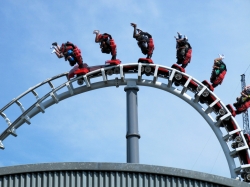Let's build a roller coaster. It will rise and fall and loop through the air. It will make people scream (in delight, not fear). In order to make our roller coaster really fun, we are going to build it high into the sky. That way it will have a lot of speed as it fall back to the ground. Now, no real roller coaster builder will start building without knowing how physics works. Those people who do not study physics ended up pushing a cardboard box around their lawn or have a roller coaster full of screaming people (in fear, not delight).
Everything has energy. Knowing that is the first step. The carts for our riders already have energy in them. If we were to set the cart on fire, it would let out some of this energy as heat and light. Of course, a roller coaster on fire would not be very nice for our riders . . . no one will ride with us if we try to light them on fire. Instead, we want to think about energy that we can use to make high speeds! One way to do this is to build up a lot of energy in the cart and let it out later as speed! To store means to save something to use later. The higher up we bring the cart, the more energy we can store for later. By changing how far away it is from the ground, we can make it go super fast when we let it fall back down.

The higher up we lift the roller coaster, the more energy we can store for later.
Jordi Payà/Flickr.com
All good roller coasters start by climbing into the air. As the tracks climb into the sky our riders start to feel more and more excited. The higher they go, the faster they can go when they fall down.
Potential energy is energy that is stored up in something. If you lift something up, you store energy in it. Let it fall back down to see what you stored let out as speed. This happens because gravity is pulling everything around us down to the center of the Earth. The higher the roller coaster climbs, the more potential energy it builds up. It's all let out when we let it fall down. That's the fun part. Back on the ground, the roller coaster had no energy. Just like that person whose roller coaster is just a box on the ground.
The world is a big place and we can think about all the energy and things happening around us. But, that's way too much for me. So that they don't go crazy, scientists choose just a few things to study at a time. With this roller coaster, we just want to look at the roller coaster moving up to store energy and moving down to let that energy out. All we want to study is the up and down movement. We want to pull the roller coaster up and let it down to make the people scream, not have to look at the clouds, the wind, the sun, your hair and all the other things around us. A system is a group of parts or things that work together as a whole. Right now, the system we are looking at involves the carts, the track, how high they go and how fast we get them to move. When you're taking notes for a class, the system you're studying is your pencil, paper and book . . . stop looking at your phone. That's not a part of the system we're studying!
To make sure that our roller coaster is as fun as we can make it, let's test it out. We could build the whole huge roller coaster, but it would be much easier and cheaper to make a smaller version first. We can do this on a computer or by making a track with straws and toothpicks. A
model is a smaller version of something you can build to look at how it will work. This is a very important step because it lets you see where you might have some weak points. If, instead of people, we put a bug on the coaster made of matchboxes, we can see how it will do. Shoot. The loop broke. Good thing bugs don't get hurt when they fall a couple inches. Just think if that was a person . . .

A model is a smaller version of something you can construct to examine how it will operate. This is a crucial step in constructing a roller coaster or any other major building because it allows you to see where your design might have some faulty points.
jula_julz/Flickr.com
Since the universe is a very big place, we are looking at a small part of it: our roller coaster as a system. It has stored energy, or what's inside of it. One way to build its potential energy is to raise it up into the sky, and release that energy by letting it fall back down again, and then build it back up once again by sending it up again. Before we start building the real thing, we made a model, a small version, to make sure that everything would work the way we think it will. That way, we can leave our riders screaming. With delight and a little fear . . . but we'll know they will be safe.

Roller coasters work with gravitational potential energy. This type will only build by traveling upward. This will also transform into kinetic energy once you've released it, allowing the gravity of the Earth to pull it back downward.
Loozrboy from Toronto, Canada, CC BY-SA 2.0 , via Wikimedia Commons
References:
Physics for Kids. "Potential Energy" Ducksters, 2011. <
http://www.ducksters.com/science/physics/potential_energy.php>
Physics 4 Kids. "Energy Around Us" Physics 4 Kids, 2013. <
http://www.physics4kids.com/files/motion_energy.html>